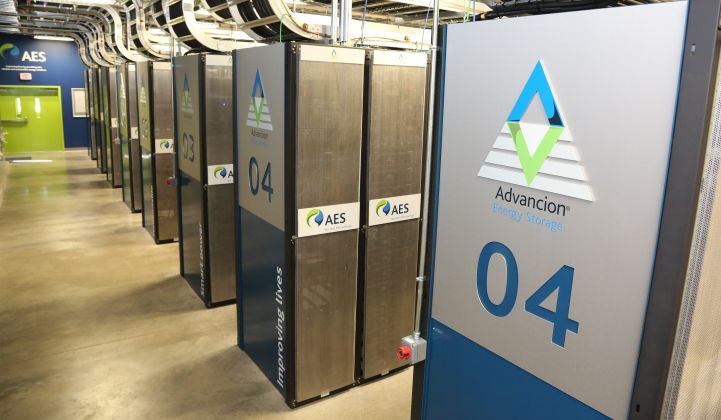Two of the biggest names in energy storage development have decided to join forces.
AES, a leader in megawatt-hours deployed, will launch a new company along with global energy systems provider Siemens. The jointly owned venture, dubbed Fluence, will scale up commercial and grid-scale storage deliveries worldwide.
The unprecedented move marks a pre-emptive consolidation of power in a young industry -- and a new competitor for emerging market leader Tesla.
AES started deploying large utility-scale storage a decade ago, making it a seasoned veteran in the new and emerging advanced energy storage world.
The major independent power producer deployed its own projects in PJM’s frequency regulation market, and gradually transitioned to selling its Advancion system to third parties. The company recently completed the largest lithium-ion battery to be deployed date for San Diego Gas & Electric as part of the Aliso Canyon gas leak response.
It could have kept going with the same game plan. But early leaders of emerging markets don’t always retain that lead. With Fluence, AES hopes to solidify its position amid an increasingly bustling competitive landscape.
“We have to massify this product to continue to bring down costs,” said AES CEO Andrés Gluski, in an interview. “On long-duration systems, we think we're the most competitive in the market, but we'll be even more competitive if we’re even larger.”
For more than a century, Siemens has built the heavy-duty equipment that drives the grid, like generators and balance-of-plant devices. In the storage space, it has focused on commercial and industrial development for the last five years with the Siestorage product, and will bring that expertise to the joint venture.
Perhaps more consequential, though, is the company’s global footprint, which includes a sales presence in 160 countries with deep ties to utility, industrial and commercial customers.
“If you look at our energy business, we’re very well connected with all the leading utility players in the world,” said Dan Wishnick, sales and business development manager at Siemens Energy. “It’s a rare customer we haven't touched in some shape or fashion.”
That should open up considerable room to expand on in the seven countries where AES has installed storage so far.
That boots-on-the-ground presence may prove to be Fluence's biggest advantage over the competition, said Ravi Manghani, storage director at GTM Research.
"There are several positives -- close to instantaneous product-to-market capability, and prompt post-sales servicing which can result in improved system uptime and availability to participate in multiple markets," he said.
The two companies will contribute more than 100 staff members to the joint venture, which will be headquartered in the vicinity of Washington, D.C. The new leadership team has not been announced. AES and Siemens will each own half of Fluence, but the new venture will operate on its own, free to focus exclusively on chasing the storage market.
The name was chosen to convey expertise and familiarity with the product.
“Both of our organizations felt a certain fluency in our space, and we wanted to own that and wrap that around us as being people who have worked in energy storage for many years,” said Stephen Coughlin, vice president for energy storage platforms at AES.
The nomenclature also reflects the confluence of two separate organizations into one, and references a technical concept in particle physics, he added.
Siemens has also conducted demonstration research on battery types other than the conventional lithium-ion. The company worked on three flow battery projects in Massachusetts, and served as EPC and integrator on Europe’s first large-scale sodium sulfur battery system.
It has an ongoing integrator relationship with Eos, which is developing a proprietary zinc hybrid cathode battery for long-duration storage. Siemens is conducting a field test of that technology at its campus in Alpharetta, Georgia.
AES has focused exclusively on lithium-ion chemistry, which dominates almost all grid storage capacity today. The scale and bankability of this technology will give it an edge for the near future, but these research efforts could help Fluence to tap niche markets that demand a different solution.
“The market is ever-changing,” Wishnick said. “If you stand still with a particular technology -- I don’t care what business you’re in, you run the risk of not advancing what you’re doing.”
This won’t be the first time Siemens has taken the plunge into an emerging clean technology. The company entered the concentrating solar power space with its $418 million purchase of solar trough company Solel in 2009.
The latter firm fared poorly in competition with cheap solar PV and natural gas. In 2013, Siemens laid off most of the remaining staff after failing to find a buyer for the firm.
Unlike CSP, lithium-ion batteries have surpassed all other competing technologies in their field in terms of market share, and AES has a strong track record in deploying it.
Fluence will chase deals in storage hotspots like the U.S., Australia and Germany, while exploring other markets in Asia and island grids, Wishnick said. Hybrid solar-plus-storage projects are very much on the table, as are storage pairings for wind or gas generators, he said.
Competition has been heating up among battery manufacturers, as market leaders like Tesla, Samsung SDI and LG Chem ramp up their production capacity. As a storage system integrator, Fluence stands to benefit from the downward pressure the gigafactory arms race puts on pricing. The global scale that Fluence aspires to opens up further savings through the bulk purchase of batteries.
If the collaboration succeeds, it will easily be the most geographically distributed grid storage development venture. The two companies together claim 463 megawatts deployed across 48 projects in 13 countries. Competitors will have to consider whether their success lies in owning a particular region, or chasing Fluence into a global theater of operations.



